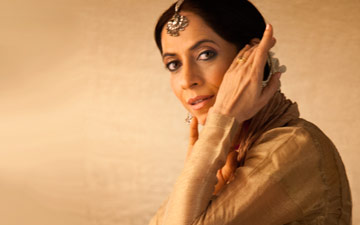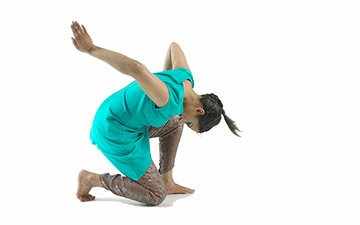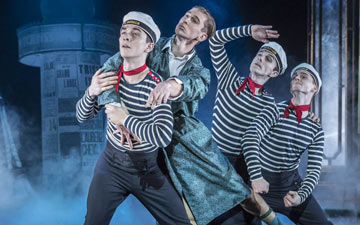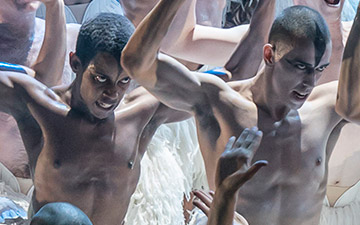
© Rehmat Rayatt. (Click image for larger version)
Darbar 2018: Sujata Mohapatra, Gauri Diwakar
Adventures in Odissi and Kathak
★★★★✰
London, Sadler’s Wells
25 November 2018
www.darbar.org
sujatamohapatra.co
www.gauridiwakar.com
www.sadlerswells.com
Adventures in Odissi and Kathak, performances of Indian classical dance, form part of Darbar, a wider festival of Indian arts including music events at the Southbank and the Barbican. The dance elements are curated by Akram Khan and are hosted at Sadler’s Wells for a second year. This show featured solo performances of Odissi dance from Sujata Mohapatra, and Kathak from Gauri Diwakar. Both these women are mature artists with years of honing their craft and they gave a commanding display. The evening allowed us to observe the differences between the expressive delicacy of the Odissi storytelling and the more expansive and speedy space-devouring moves of Kathak. Each had its distinct flavour with different qualities to enjoy.
Akram Khan was on hand to chat to the audience about his choices. Though an exponent of kathak himself he recalls seeing Odissi as a child and wondering if he had made the right choice. He was keen to stress the long heritage of both forms, and how faithfully Sujata Mohapatra carried on the traditions of her teacher and father in law, Padmabibhushan Kelucharan Mohapatra. It was his work that formed the largest section of her performance.
One of the musicians gave us a helpful (if very quietly spoken) introduction to the narrative that unfolds of the events that led up to the abduction of Sita by a demon. Sujata Mohapatra is costumed in brilliant red and blue, bells at her ankles, the soles of her feet painted red, with a resplendent headdress. She embodies all the characters in the drama. It’s very striking how she physically transforms from moment to moment. She is taller and more powerful as she draws a bow and dispatches an arrow, and then moments later as Sita she is softer, smaller, bending delicately, inclining her head. As the demon, she strides forth with confidence and power.
Complex storytelling like this needs a lot of concentration from the audience, but Mohapatra certainly knows how to hold our attention. She has a very mobile expressive face with a particularly winning smile and knows exactly how to use her eyes and the direction of her gaze to maximum effect. She does not cover a great deal of ground in her movements but instead pulls your attention toward her. This is not a performance of big individual showy gestures: its effect is built up of many tiny exquisite details, the sideways glances, the filigree curling of the fingers, the small but swift steps that sound the ankle bells. Her technical command in these details is impressive but subtle. Her feet may be beating out a rhythm, her head moving from side to side, but the torso remains utterly still. Any difficulties are artfully concealed. Balancing on one leg while slowly revolving is apparently effortless.

© Rehmat Rayatt. (Click image for larger version)
Gauri Diwakar is a pupil of Aditi Mangaldas (who danced at last year’s Darbar herself), and it is she who has choreographed this solo for Diwakar. Hari Ho Gati Meri (“Let my salvation be in the supreme”), is inspired by the words of four Muslim poets, each taking Krishna as their subject.
Diwakar is a forceful and commanding figure, possessed of considerable authority. This is less of a theatrical presentation, more purely dance. The interplay between the dancer and the musicians is much more to the fore, as they push each other on. She eats up space across the stage as the music impels her through whirling turns. Her long yellow dress billows out dramatically as she spins. Her arms scythe decisively through the air, to finish with a flourish. The audience responds with whoops of delight. The slap of her feet on the stage seems harsher and more emphatic than Mohapatra’s gentler pulsations. An instrumental interlude, after half an hour, gives her a break to catch breath and change costume, and allows the musicians’ virtuosity free rein.
There are seven musicians in total, only four performing during each solo, with a different mix of instruments for each performer. The bansuri wooden flute adds a particularly otherworldly quality to the mix. The elegant lighting installation from last year’s Darbar performances was so appreciated that it was retained. A mass of individual lights hanging on wires can be separately raised or lowered to form a rippling wave or golden net. Khan asked for something that would evoke the lights in a temple, and this makes an atmospheric backdrop.
Both solos are substantial at around an hour each. Indian audiences, like the performers, have considerable stamina. After these, the two women come together for a final duet created by them especially for this event. In western dance forms duets between women (as opposed to confrontations) are relatively rare. Here the performers made it work while remaining true to their art forms. Diwakar’s turns circled the stage while Mohapatra occupied the centre showing the elegant tracery of her arms. The piece had a sculptural quality as if two statues had descended from a temple façade to have a conversation with one another.
Adventures in Odissi and Kathak was an absorbing and illuminating evening, rewarded with a standing ovation from an engaged and responsive audience.

















As Jeffersoon says in Hamilton “What did I miss?” It sounds like one
sublime evening for an Indian dance buff. Thank you very much for such
keen observations.